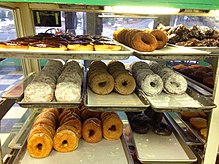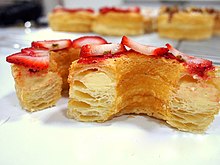donut

A donut ( [ˈdoʊ̯nat] or [ˈdoːnat] ; from the American English donut from donut , from dough dt. “Dough” and nut in the older meaning “small round cake or biscuit”) is a palm-sized American / Canadian donut made from yeast dough or sponge cake (also called lard biscuits or hole donuts). The shape is either a torus (ring similar to a bagel ) or - more rarely - a flattened ball, which often contains chocolate or some other sweet filling.
The pastry
Donuts are made from a special batter and fried in fat . The baked donut is covered with different glazes such as chocolate couverture or colored glaze (fat-sugar mixture).
The characteristic torus shape was created in the 19th century.
In Europe, donuts were relatively unknown under this name for a long time, but from around the year 2000 they have become more and more common. In the USA and Canada they are firmly anchored in everyday culture . Various fast-food chains have specialized in donuts there, for example Dunkin 'Donuts , Tim Hortons , Winchell's Donuts, Country Style, Batriks Donuts and Krispy Kreme . Krispy Kreme and Dunkin 'Donuts have now also established themselves in Europe (Great Britain, Spain and Germany). The largest donut producer in the US is Krispy Kreme, followed by Dunkin 'Donuts. Both have their own chain of stores, and Krispy Kreme products are also sold in many supermarkets and gas stations in the United States.
Donut maker
Donut makers, which work on the principle of a waffle iron , have been increasingly available in stores since 2008. They offer the option of baking usually six very small (so-called mini) donuts. Due to the different method of preparation, these are not completely identical to conventional donuts.
The donut effect
In technology, the donut effect is desired for thorough mixing of the material to be stirred . However, the “edible” is less important here than the formation of such a toroidal shape as is typical for the donut, i.e. a 360 ° drift rotation on the spot. The stirring or grinding stock is by the rotating stirring tool, z. B. a dissolver disc , set in motion and promoted to the outside by centrifugal force . The material flow splits at the container wall and is deflected towards the center. One part runs back to the stirring tool at the bottom of the container, the other forms the "donut" on the surface. Parts of the stirring tool run free and become visible. The effect of the household mixer or the dough kneader of the food processor when using a single stirring rod is comparable to this.
In urban development , the donut or donut effect describes a migration movement from the inner city to the outskirts. The American spelling donut describes the phenomenon that often occurs in America of the higher earners migrating to the fringes, while the poorer sections of the population remain in the center. In contrast, the British spelling donut is chosen to denote the European variant, in which the city center is often upgraded by migration.
Donut sign / Donut sign in medicine
In medicine, the "donut sign" or "donut sign" is described in the ultrasound:
- If a nerve is completely washed around with local anesthetic during peripheral regional anesthesia, it appears to "swim" in the local anesthetic in the two-dimensional ultrasound image (cross-sectional representation of the nerve). The picture shows a dark (hypoechoic) liquid ring around the light (hypoechoic) nerve; this is known as the donut sign. If such a flush is achieved, a certain blockage of the nerve can be assumed.
- Conversely, in the case of intussusception (invagination) of the intestine, ultrasound often finds a central hypoechoic area surrounded by a hyperechoic ring. In German medicine, the term target sign has established itself, in English the bulls eye sign or donut sign is also used.
Cronut
In 2013, cronuts became known as the new trend pastry from New York . They form a cross between a croissant and a donut. It was developed in 2013 by the French Dominique Ansel in New York. In 2013, the Cronut was named one of the "25 best inventions of 2013" by Time Magazine .
Literature and film
- Donuts are one of Homer Simpson's favorite foods from the animated series The Simpsons .
- Donald Duck bakes them (in the German translations of the comics) as "Schmalzkringel", "Lochkringel" or "Pancake".
- In the film Mr. Deeds Goes Into Town , the main actor Gary Cooper feeds a horse with donuts during a drinking spree at a street crossing.
- The cliché that US police officers live mainly on donuts and coffee is taken up in countless works, including the Simpsons .
- In Full Metal Jacket there is a scene in which an overweight private hides a jelly donut in his box that he has illegally taken from the canteen.
- A donut is presented by a friendly cop in Frank Zappa's Joe's garage .
- In the series Dexter , protagonist and serial killer Dexter Morgan's routine every morning is to get donuts for his colleagues in the Miami Metro Police Department.
Web links
literature
- Michael Krondl: The donut: history, recipes, and lore from Boston to Berlin . Chicago Review Press, Chicago 2014, ISBN 978-1-61374-670-7 .
Individual evidence
- ↑ [1]
- ^ Donut in the American Heritage Dictionary
- ↑ donation in the Merriam-Webster Online Dictionary
- ↑ donut in the American Heritage Dictionary
- ^ "Donut" in the Online Etymology Dictionary. Retrieved July 19, 2017 .
- ↑ Michael Krondl: Donuts . In: Darra Goldstein (Ed.): The Oxford Companion to Sugar and Sweets . Oxford University Press, New York 2015, ISBN 978-0-19-931339-6 , pp. 225–227 (English, limited preview in Google Book Search).
- ↑ Thomas Brock, Michael Groteklaes, Peter Mischke: Textbook of paint technology . Ed .: Ulrich Zorll. 2nd Edition. Vincentz Verlag, Hannover 2000, ISBN 3-87870-569-7 , chap. 4.9.3 Dispersing with the dissolver, p. 241 f . ( limited preview in Google Book search).
- ↑ Oliver Schöller-Schwedes, Stephan Rammler: Mobile Cities: Dynamics of worldwide urban and traffic development . In: Mobility and Society . 2nd Edition. tape 2 . LIT Verlag Münster, Berlin 2012, ISBN 978-3-8258-0913-3 , III. Urban and traffic development in an international comparison - an inventory, p. 24–26 ( limited preview in Google Book search).
- ^ British Journal of Anesthesia. Retrieved January 22, 2019 .
- ↑ intussusception - The donut sign or target sign, the pseudo kidney sign - Critical Care Sonography. Retrieved January 22, 2019 (Australian English).
- ^ Frank Gaillard: Target sign (intussusception) | Radiology Reference Article | Radiopaedia.org. Retrieved January 22, 2019 (American English).
- ↑ http://dominiqueansel.com/time-magazines-25-best-inventions-of-2013-the-cronut


